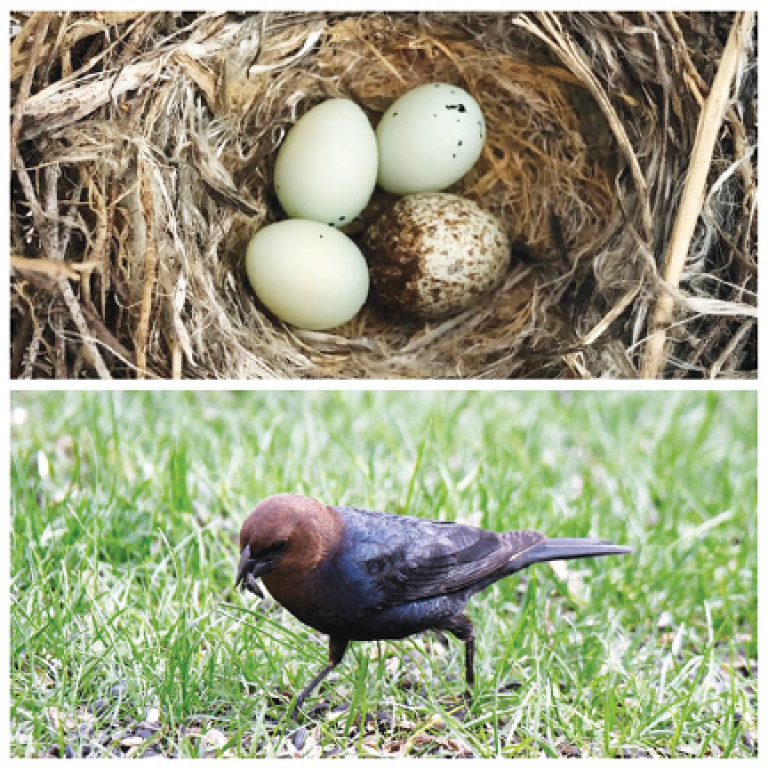When we were very young, my mom was big on recitation and definitely had her favorite books and children’s poems that she would perform for us. After dozens of these renditions, we too could chime in on the classic nursery rhymes and cautionary tales. One of our collective favorites in her repertoire was Dr. Seuss’ Horton Hatches an Egg. In that book, Horton gets snookered by Mayzie, a lazy bird and ends up sitting on her egg while she heads off to Palm beach. Kind and patient, Horton sits on the egg through all sorts of weather and faces teasing by his animal friends but stays the course. At the end, when Mayzie meets up with Horton as the egg is about to hatch, naturally, like most ne’er-do-wells, she wants the egg back. But Horton’s persistence pays off as the hatchling turns out to be an elephant bird, and both Horton and the elephant bird find their way back into the wilderness with no sign of Mayzie in their happily ever after story.

If you happen to see cowbird eggs in a nest, please leave them alone. It is best not to interfere with nature.
Suess’s Mayzie was all about evading responsibility, and she got her just desserts for that. We have a local bird that has jumped on Mayzie’s bandwagon, the cowbird. The female cowbird shuns the traditional avian lifestyle and does not even bother with the charade of nest building. Instead, she puts all of her energy into egg production. When the coast is clear, she lays her eggs in other birds’ nests leaving the egg to be incubated and raised by some unsuspecting host bird while the cowbird lives the life of Riley. Not surprisingly, cowbirds are considered brood parasites for this behavior. The male and female cowbirds are swingers, and with this freedom and no brood to tie them down, they have multiple mates. The female can really churn out the eggs laying up to thirty-six eggs in multiple birds’ nests in a summer. The cowbird chick usually hatches before the other eggs, and she may smother the other chicks, push the other chicks out of the nest or just consume the majority of the foster parents’ food, ensuring her survival and jeopardizing the survival of the other birds. Surely the old adage rings true that the apple does not fall far from the tree, and the cowbird offspring are just as shifty as their parents! It has been determined that there are 220 species of birds that have been taken advantage of by the cowbird’s antics. Quite often some diminutive, little bird mama spends all her day feeding this giant bird baby that appeared in her nest one day. I wonder what she is thinking. I find the mama bird’s efforts relatable since I spent my fair share of years feeding some giant toddlers, and later adolescents who bore little resemblance to anyone in our family tree. But what goes around comes around, and sooner or later the toddlers grew up and went off to college to evade responsibility, cowbird style, somewhere else.
If you are wondering if you have a shirker in your neighborhood, you probably do. Look for a mid-sized short-tailed bird with pointed wings. The males have a black body, sometimes trending towards iridescent, and a brown head. The females are a more subtly colored tannish. Cowbirds prefer to reside in open fields as they are grain eaters who often hang around with bovines, hence their name. They like to join in mixed flocks with other blackbirds and sometimes they visit bird feeders en masse. They are very human tolerant and are plentiful in these parts with their numbers increasing.
Begrudgingly, I have to hand it to the cowbird and their Mayzie-style ingenuity. They are clever and opportunistic, simply resorting to behavior that is ingrained in them. That’s all good and fine, but I am seeking out the Hortons of this world, hardworking, not perpetually plotting, who know something about the high road. There is something very appealing about such a straightforward existence not to mention the bonus of the happily-ever-after ending. At least that’s how it works in children’s books.